These Sourdough Sprouted Wheat Loaves made with 60 percent sprouted red fife flour, are chewy and nutty due to the inclusion of roasted sunflower seeds.
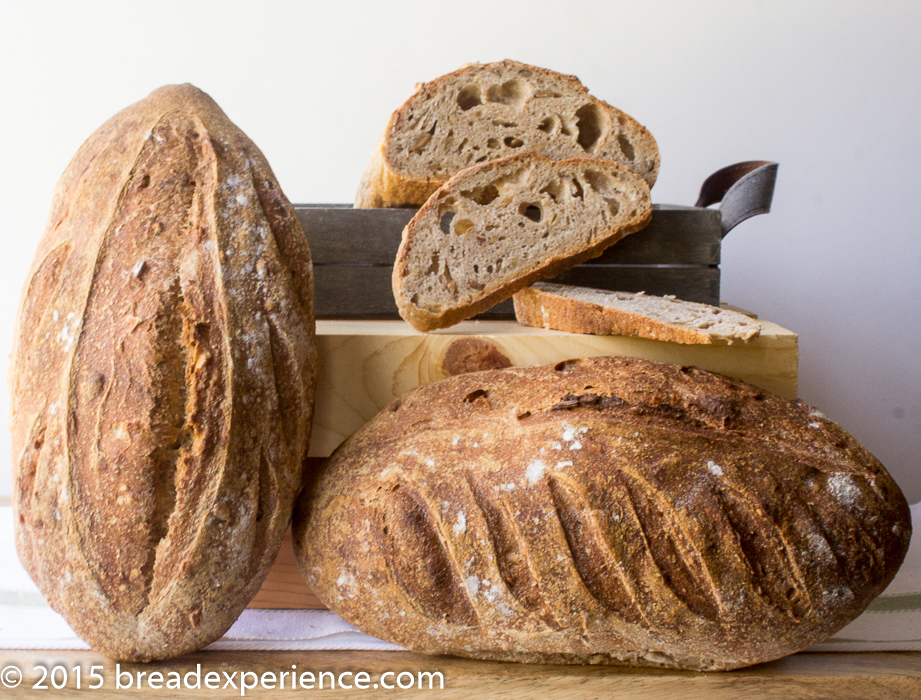
I got the idea for these loaves from the sourdough artisan bread rolls we made for the BOM challenge for the Artisan Bread Bakers FB group. I adapted the formula to utilize a 60/40 ratio of sprouted wheat flour to all-purpose flour and added some roasted sunflower seeds to the mix. Instead of shaping them into small batards, I shaped them into three loaves.
The first time I made this bread, I used about 70% sprouted whole wheat flour that I had sprouted and dried. When I sprouted the grains, I was planning on making sprouted wheat bread with no flour; however, I let the grains sprout too long. So instead of using the sprouts, I let them dry completely and then ground them in flour and stored the flour in the freezer. The flour had been sitting in my freezer for a couple of months waiting to be tested, but I had forgotten that the grains had sprouted too long and might not perform well in bread.
I proceeded with making the loaves and was so pleased with the way they looked after being baked. However, looks can be deceiving. When I sliced into one of the loaves after letting it cool, it was gummy on the inside. I ended up baking the loaves two more times, but they never did bake through.
This is what happens when you use grains that sprout too long
If you ever wonder what will happen if you use sprouted flour from grains that have sprouted too long, this is it. You may not be able to tell in the crumb shot, but it was gummy on the inside.
- Sprouted Wheat Bread – Take 1 Looks good
- Looks can be deceiving – gummy on inside
I was bummed about this failure until I remembered that the flour I used had sprouted too long. So I decided to use this as a teachable moment. The good thing about this test is now I know what happens when you try to use flour from grains that have sprouted too long. It doesn’t bake through because it’s too starchy.
This is the same result you get when making sprouted bread with no flour from grains that have sprouted too long so the fact that this happened makes perfect sense. I was just hoping for a different result.
I liked the way the loaves turned out, except for the gumminess, so I decided to try again. However, rather than sprouting the flour myself, this time I used sprouted wheat flour I got from the Maine Grain Alliance. The result was much better. No gumminess!
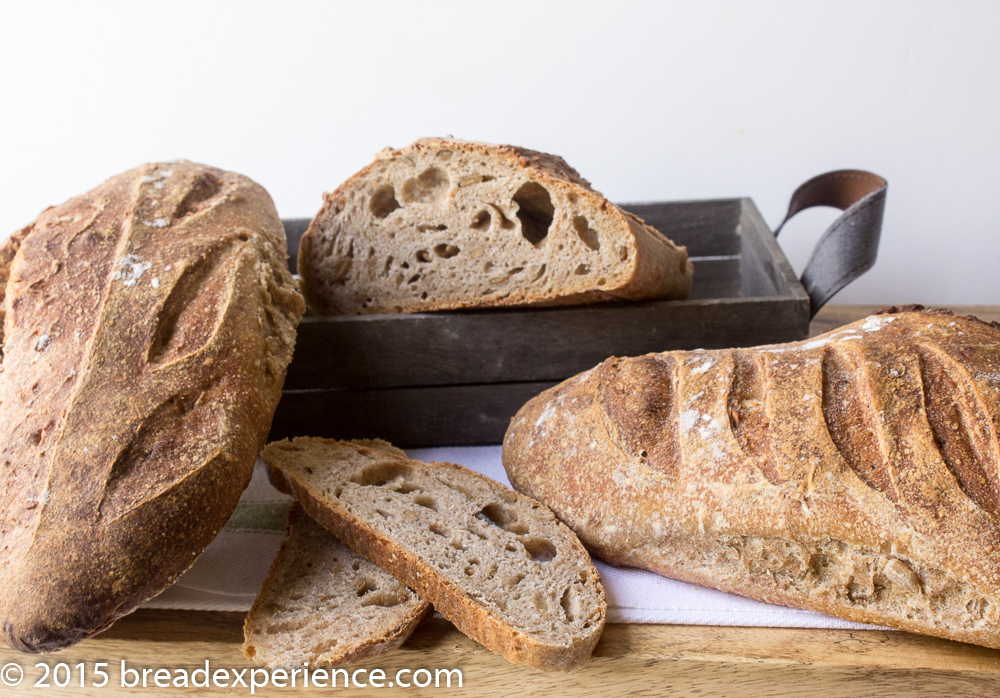
Equipment needed:
- Mixing bowls
- Danish dough whisk or large wooden spoon
- Plastic dough scraper or spatula for scraping down the bowl
- Bench knife for scraping counter and lifting dough
- Parchment paper or silpat to line a baking sheet or couche
- Baking Sheet or Baker’s Peel for transferring loaves to preheated stone
- Bread scoring lame or knife
- Baking Stone or Tile
- Cooling rack
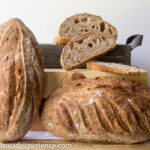
Sourdough Sprouted Wheat Loaves
- Yield: 3 Loaves 1x
Description
These Sourdough Sprouted Wheat Loaves made with 60 percent sprouted red fife flour, are chewy and nutty due to the inclusion of roasted sunflower seeds.
Ingredients
- 600 grams sprouted wheat flour (I used red fife)
- 400 grams all-purpose or bread flour
- 650 grams water
- 22 grams salt
- 200 grams 100% hydration active sourdough starter (i.e. 100 grams flour and 100 grams water)
- 75 grams roasted sunflower seeds
Instructions
Day 1:
- Place sourdough starter in a large bowl. Pour in 60% of the water and mix with a wooden spoon or Danish dough whisk to break up the starter.
- Whisk the dry ingredients together in a separate bowl and add to the sourdough/water mixture.
- Mix using a wooden spoon or Danish dough whisk until the dough is too thick, then continue mixing with wet hands. Gradually add the rest of the water and mix thoroughly until the flour is completely incorporated and the dough is a shaggy mass.
- Form the dough into a rough ball, and place into a lightly greased bowl. Cover and let it rest for 20 to 30 minutes.
- Knead in the roasted sunflower seeds. Shape into a ball again and place in greased bowl.
- Cover again and let the dough bulk ferment for two hours.
- Perform two stretch and folds during the first hour; once every 30 minutes. Let the dough rest for the 2nd hour.
- Cover the dough tightly and place in the refrigerator overnight.
Day 2:
- The next day, remove the dough from the refrigerator and allow it to warm up to room temperature for 1½ to 2 hours before shaping.
- Divide the dough into three equal balls and let them rest on the counter for 20 minutes.
- Shape into batards and place them on cornmeal-dusted parchment paper (or a silpat).
- Let the loaves rise at room temperature for 45 minutes to an hour.
- While the dough is on its last rise preheat your oven to 475 degrees F. with a baking stone on the bottom rack and steam pan (or iron skillet) on the top shelf.
- Score the loaves in the pattern of your choice. I sprinkled the tops of the loaves with flour so the lame wouldn’t drag through it.
- Slide the loaves onto the preheated baking stone using the back of a baking sheet or a baker’s peel. Immediately throw 3 or 4 ice cubes in the steam pan to generate steam. You can also spritz the loaves once or twice during the first couple of minutes of baking.
- Bake the loaves for 5 minutes, then turn the temperature down to 450 degrees F. and let them bake an additional 30 – 35 minutes or until the loaves are golden brown and sound hollow when thumped on the bottom.
- Remove the loaves from the oven and place on a wire rack to cool.
- Category: Sourdough Sprouted Wheat Loaves
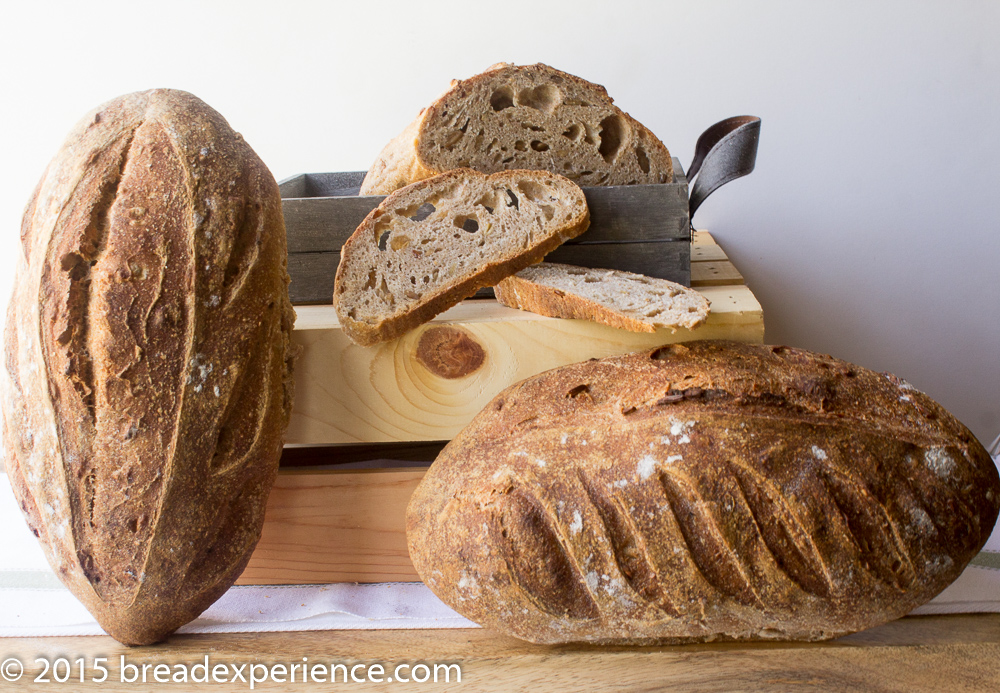
Happy Baking!
Cathy
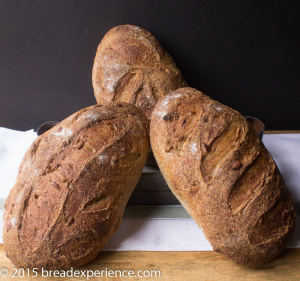
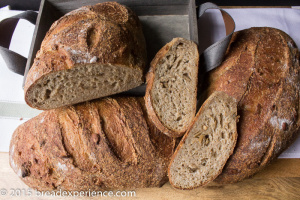
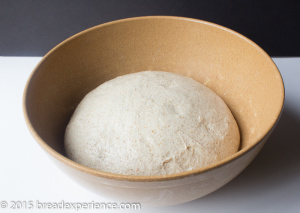
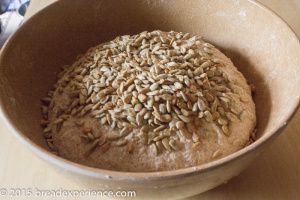
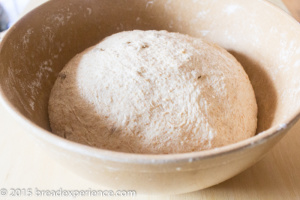

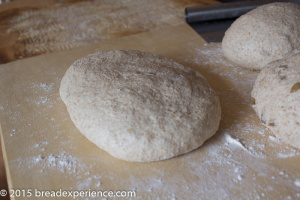
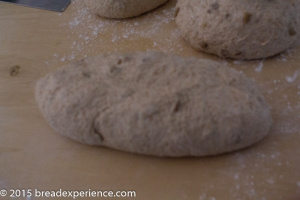
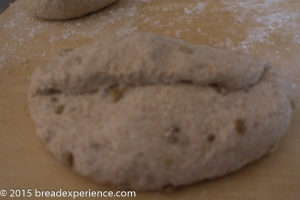
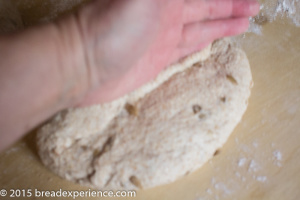
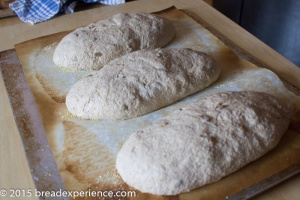
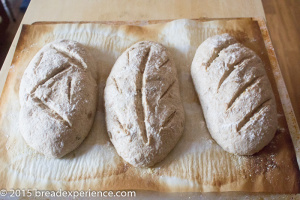
Leave a Reply